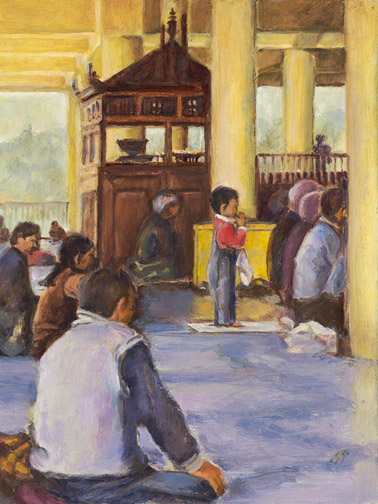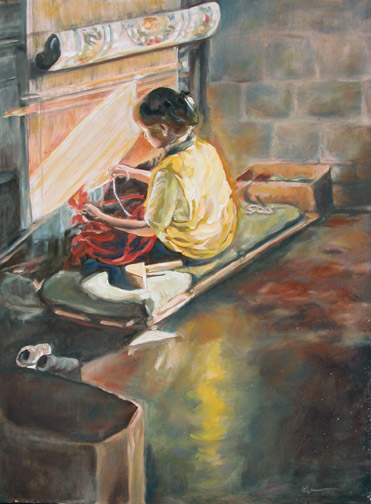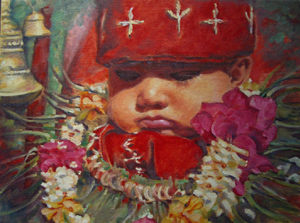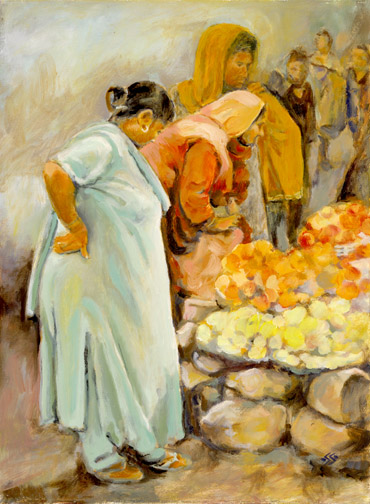Gicleé Fine Art
Prints
|
||
|
For more information on what a giclée or fine art print is, see
below. |
||
 |
 |
 |
Learning to Pray The
image on the giclée print of "Learning to Pray" is 8.5"
x 11.5", printed on 11" x 14" archival, acid-free rag paper.
It is limited to 60 editions. In this painting we see a few of the hundreds of people worshiping along with the Dalai Lama in the Tsuglagkhang, or Central Chapel, in Dharamsala. This building is the exiled government's equivalent of the Jokhang Temple in Lhasa, and the most important Buddhist monument in Dharamsala, India.The service is 2-3 hours long and the atmosphere is spiritual yet casual as the adults and children come and go, bow, chant, drink tea, nurse babies and so on. The young child in the middle is learning to pray and do prostrations (bow) from watching those around him. For a larger image, information on the original painting see:: "Pray" information |
Tibetan Weaver SOLD OUT The image on the giclée print of "Tibetan Weaver" is 14" x 18.5", printed on 16" x 21" archival, acid-free rag paper. It is limited to 60 editions. When refugees
arrive in Dharamsala from Tibet, often the first work find is in creating
the beautiful traditional Tibetan crafts. This young woman is working
on a Tibetan carpet for the handicraft center in Dharamsala. For a larger image, information on the original painting see: "Weaver" information |
Nepali Baby The
image on the giclée print of "Nepali Baby" is 8.5"
x 11.5", printed on 11" x 14" archival, acid-free rag paper.
It is limited to 100 editions. At 6 months of age a child celebrates his or her first meal. This is the son of a Montessori teacher Susan was visiting in Nepal. He was dressed in the traditional costume, eyes kohled against the harsh Himalayan sun and for beauty, and accompanies by the large extended family, attended a Hindu ceremony in his honor at the local temple. After prayers he was seated on the ground on his mother's lap and for hours, offered a taste of his first solid meal, a special rice pudding served from a silver spoon and bowl created for the occasion. |
Giclée Printing THE
DEFINITION: : Giclée (zhee-klay) - The French word "giclée" is a feminine
noun that means a spray or a spurt of liquid. The word may have been derived
from the French verb "gicler" meaning "to squirt". |
Contact susanonly@earthlink.net
THE TERM: The term "giclée print" connotes an elevation in printmaking technology. Images are generated from high resolution digital scans and printed with archival quality inks onto various substrates including canvas, fine art, and photo-base paper. The giclée printing process provides better color accuracy than other means of reproduction. |
 |
|
THE PROCESS: Giclée prints are created typically using professional 8-Color to 12-Color ink-jet
printers. Among the manufacturers of these printers are vanguards such
as Epson, MacDermid Colorspan, & Hewlett-Packard. These modern technology
printers are capable of producing incredibly detailed prints for both
the fine art and photographic markets. Giclée prints are sometimes mistakenly referred to as Iris prints, which are
4-Color ink-jet prints from a printer pioneered in the late 1970s by Iris
Graphics. THE ADVANTAGES: Giclée prints are advantageous to artists who do not find it feasible to mass
produce their work, but want to reproduce their art as needed, or on-demand.
Once an image is digitally archived, additional reproductions can be made
to order. The prohibitive up front cost of mass production for an edition
is eliminated. Archived files will not deteriorate in quality as negatives
and film inherently do. Another tremendous advantage of giclée printing is that digital images can be reproduced to almost any size and
onto various media, giving the artist the ability to customize prints
for a specific client.
|
THE QUALITY: The quality of the giclée print rivals traditional silver-halide and gelatin printing processes
and is commonly found in museums, art galleries, and photographic galleries. THE MARKET: Numerous examples of giclée prints can be found in New York City at the Metropolitan Museum, the Museum of Modern Art, and the Chelsea Galleries. Recent auctions of giclée prints have fetched $10,800 for Annie Leibovitz, $9,600 for Chuck Close, and $22,800 for Wolfgang Tillmans (April 23/24 2004, Photographs, New York, Phillips de Pury & Company.) |
Kotwali Bazaar The image on the giclée print of "Kotwali Bazaar" is 8.5" x 11.5", printed on 11" x 14" archival, acid-free rag paper. It is limited to 60 editions. Dharamsala is also known as "Little Tibet" because it is the center of government for the Tibetan exile community. There Tibetans and Indians live together. In this picture Indian women wearing the traditional Salwar (pants) Kameez (shirt) and Dupata (scarf) are carefully picking out fruit at the market, or kotwali bazaar of lower Dharamsala. For a larger image, information on the original painting, and size of the print, see:"Kotwali" information |
|
Return to: www.susanart.net |
||